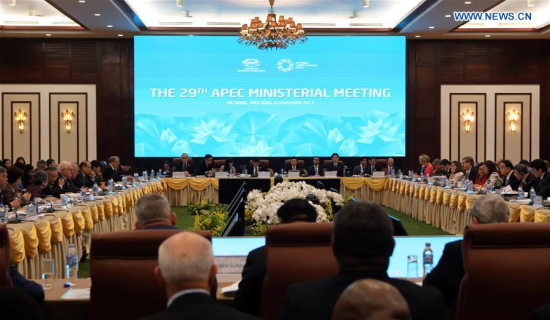
The 29th APEC Ministerial Meeting is held in Da Nang, Vietnam, on Nov. 8, 2017. (Xinhua/Li Peng)
The Free Trade Area of the Asia-Pacific (FTAAP) was brought under the spotlight again this week, as delegates from 21 Asia-Pacific Economic Cooperation (APEC) economies gathered here in Vietnam's Da Nang city for the annual economic leaders' meeting.
The vision to build FTAAP, proposed at the APEC meetings in Hanoi, Vietnam in 2006, was translated into reality at the 2014 APEC meetings in Beijing with the endorsement of a roadmap. A collective strategic study was conducted subsequently and the result was approved at the APEC meetings in Lima in 2016.
APEC members are expected to further discuss issues related to the proposed trade deal at this year's annual meetings.
A report from the Pacific Economic Cooperation Council (PECC) has estimated that the FTAAP, when realized, will add 2.4 trillion U.S. dollars to the global economy.
COMMITMENT TO MULTILATERALISM
The call for accelerating the FTAAP process comes amid slow and vulnerable recovery of the world economy, with the Asia-Pacific region becoming the powerhouse for economic growth.
The World Bank estimated global growth in 2017 to accelerate to 2.7 percent, while East Asia and Pacific, and South Asia take the lead with 6.2 percent and 6.8 percent of projected growth respectively.
However, protectionism and policy uncertainties are still haunting global economic recovery.
"Protectionism is certainly affecting free trade," Tang Guoqiang, international co-chair of PECC, told Xinhua on the sidelines of the APEC meetings. He noted that the global trade growth has been slower than the global GDP growth in the past year, a phenomenon that worries some economists.
The past year has seen some incidents that fueled global concern over protectionism, including the United States' withdrawal from the Trans-Pacific Partnership (TPP) and other multilateral mechanisms. The trend of de-globalization also emerged in other industrialized countries.
"The commitment to multilateralism seemed to have been lost in recent years in industrialized countries," Peter Drysdale, head of the East Asian Bureau of Economic Research and East Asia Forum in Australian National University, told Xinhua.
"And if the APEC economies, most of them, nearly all of them, don't assert that principle very strongly, then the whole rationale upon which the East Asia and Asia Pacific economic prosperity is based will be under threat," he said.
INTEGRATING REGIONAL FTAs
The plethora of bilateral and regional trade agreements in the Asia-Pacific region is a testament to both developed and emerging markets' enthusiasm for free trade and open economy. By the end of 2015, some 160 Free Trade Agreements (FTAs) had been signed between APEC members, including over 60 regional FTAs.
But the presence of a complex web of trade deals, known as the "spaghetti bowl" effect, is likely to lead to higher administration costs, while the trade diversion effect may offset the initial gains of FTAs, according to the Collective Strategic Study on Issues Related to the Realization of the FTAAP approved by leaders of APEC members in 2016.


















































